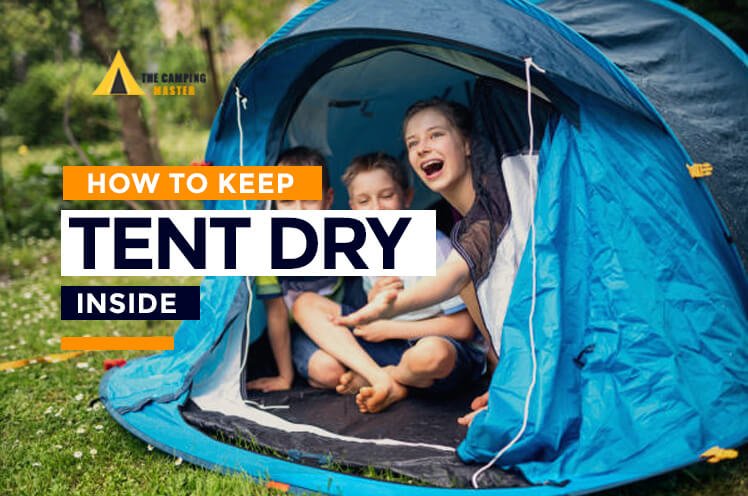Keeping your camp dry is very important as damping can make you uncomfortable and cause health problems. Especially people who have any respiratory issues may face difficulty in damped air.
Sleeping in a damp place is much more challenging during cold weather. If you don’t know how to keep the tent dry inside? Do not worry. I share some easy tips & tricks in this article that will help keep your tent dry inside.
Keeping the tent dry inside is not a challenging task. Only some simple tricks will help you stay moist out of your tent. Read this informative article to learn how to keep tent dry inside.
How To Keep Tent Dry Inside? Here are 15 Best Ways to Keep the Tent Dry Inside
Here are some Simple and easy tips and tricks that will help you to know “how to keep the tent dry inside.”
1. Planning a suitable location
First, select the best location for your camping to avoid damping inside your tent. While choosing the place, you should keep the following points in your mind:
- The site should not be too cold as it can increase damping and put you in trouble.
- The location should be away from water bodies.
- It should be a little higher as, at height, the air is a little less damp.
2. Check the weather of your camping location
If you want to keep your tent dry inside, it is advisable to check the weather condition of your camping site before you leave for your camping trip. Checking the weather will help you avoid places with rain chances. It could be very hectic to keep tent dry inside during the rain.
3. Buy a multi-layered tent
While buying a tent for your campsite, choose a camp with double or triple layers. The multi-layered tent will help you keep your tent dry inside by keeping the outside cold layer away from the inside warm air. Doing this prevents condensation, and your tent will stay dry even in cold weather.
4. Buy a waterproof tent
Here is one more tip on how to keep the tent dry inside. Always buy a waterproof tent, not a water-resistant tent. The waterproof material is perfect and doesn’t absorb water at all and thus helping you to keep your tent dry inside. Especially in case of rainy weather, it will be helpful for sure.
5. Setting up your tent
If you don’t know how to keep tent dry inside, setting up your tent in the driest possible place will help you to keep the tent dry inside. Avoid placing your tent on grassy areas as it will wet the bottom of your tent.
Setting a tent near trees is a good decision. Trees will provide you with shadows and fresh air. Trees are also used for tying up tarps and ropes to hang your clothes in sunlight.
6. Check for leakage intent
It is also important to check your tent thoroughly. Any leakage in the tent will let rainwater inside the tent in case of rain. To avoid any trouble, cover the leakage adequately. Otherwise, it will be hard for you to keep your tent dry inside.
7. Proper ventilation inside the camp
To keep your tent dry inside, you should focus on the tent’s ventilation. Proper ventilation is essential. Poor ventilation can cause condensation inside the tent. Try to put your tent in a ventilated place for good ventilation. If you pitch your tent facing the breeze, the air will circulate inside your tent and will help to keep the tent dry.
8. Use a tarp
Tarp is a multi-functional and precious item while camping. You can use a tarp for:
Covering the tent’s floor: Using a tarp inside the tent would be best to cover the floor. Covering the floor will prevent your gears from getting wet.
Covering the top of the tent: You can also use a tarp to cover the top of your tent. Using a tarp will provide you extra protection while raining.
Cover yourself: Outside the tent, you can use a tarp to protect yourself from rain. As a tarp is waterproof, it will save your clothes from getting wet. Wet clothes can cause damping inside the tent.
As an extension to your tent: You can use a tarp to extend your tent and create a porch. Hanging the tarp outside your tent will create a shadow for you.
To cover your gears: You can also use a tarp to protect them from rainwater. You can wrap the tarp above the gear and zip your backpack. In this way, you can provide extra protection to your gear.
9. Create a porch area outside your tent
Here is one more tip for how to keep your tent dry inside. You’ll have extra space by creating a porch in front of your tent. It will also hold water moist far from inside of your camp. You can use this area for cooking food under the shadow. However, it is a little hard to tie the tarp. You can tie it with trees, or you have to install support pools for it.
10. No wet gears inside the tent
You should stick to the rule, “No wet gears inside the tent.” If you take wet gears inside the tent, they’ll cause damping. To keep your tent dry, avoid bringing water inside the tent, as water in wet gears has no escape.
It would help to leave your wet clothes or shoes on the porch area. Hanging wet gears in the porch area will help them dry earlier and keep them moist outside.
11. No cooking inside the tent
Cooking inside the tent can cause a dangerous situation as tents are highly flammable. Also, cooking inside the tent will cause condensation inside the tent. Always cook outside and in the open air to get maximum ventilation.
If you want comfortable sleep, avoid bringing any water inside your tent. In case of rain, you can cook on your porch area.
12. Dry your tent
If your tent is wet, let this dry in proper sunlight. Fold the entrance of your tent and allow the air and sunlight to reach the tent. It is an effortless way of drying your tent inside. Let nature do this task for you. Make sure to dry your tent before packing. You can also use a fan or dryer to speed up the drying process.
13. Using a towel or sponge
If your camp walls are damp, you can use a towel or sponge to absorb the water droplets. The towel can also help soak up water from your tent in case rainwater gets into your tent. Always pack a towel or sponge with you.
14. No heater inside the tent
Here is the best tip for how to keep the tent dry inside. Avoid using a heater inside the tent. Use of heater inside tent cause damping of air inside the tent. This warm air condenses and wets the walls of the tent. So, using the heater in the tent is not advisable to keep your tent dry.
15. The heat from the campfire
The heat from the campfire will help your tent stay drier. Especially in cold weather, campfire heat can prevent condensation in your tent. But this could be a little dangerous too. As you know, tent material is highly flammable, and a little blaze can put your tent on fire. However, it helps dry other wet gears.
Final Thoughts: How To Keep Tent Dry Inside?
In this article, I have mentioned maximum tips and tricks that will help you to find the answer that “how to keep tent dry inside.” All the information in this valuable article will help you for sure that primarily focus on the material of the tent to avoid getting wet. The waterproof tent will save you from a lot of problems. Waterproof tents can save your gear, too, by protecting them from rain and keeping them dry. You’ll need to take some extra precautions in case of rain. So keep in mind all the possible situations and be ready to handle them.
Setting your tent is also an important milestone, so you should also pay attention to all the factors and set the tent according to them. Camping is really fun and is worth spending money and time. Go and enjoy your vacation but do not forget to follow the above instructions. Otherwise, you’ll regret it.
Frequently Asked Questions: How To Keep Tent Dry Inside?
Here are some more questions most people ask related to how to keep the tent dry inside. These shells help you get more knowledge.
1. How do I prevent my tent from getting wet?
Answer: When you read how to keep tent dry inside, the question of how I prevent my tent from getting wet also arises. Here are some tricks and tips:
- The best way to keep your tent from getting wet is to use a tarp as a shelter. It will help you keep water away from your tent.
- Use a ground sheet to avoid moisture from the bottom. But remember one thing, do not use a large sheet. It will cause more water to stand and get inside your tent. Always use a perfect fitted ground sheet.
- Choosing the right location for your tent also plays an essential role in preventing your tent from getting wet.
2. How often does a tent need waterproofing?
Answer: It would help if you waterproofed your tent once a year. If camping in an area with more rainwater, you’ll need to waterproof your tent most often. If you want to avoid waterproofing your tent, you should look for a shady place to put a tent. It will decrease exposure to rainwater.
3. Can you waterproof the inside of your tent?
Answer: No, this is not possible. You cannot waterproof your tent inside. You can do something to keep your tent dry inside, like you should install your tent in the right location. Check weather conditions and avoid camping in direct rain. Try to install your tent in a shady place.
Also, keeping the door and windows open helps you keep your tent dry inside. Ventilation will help you prevent building condensation inside the tent.
4. How to prevent tent condensation?
Answer: If you want to prevent building condensation inside the tent, you should avoid bringing wet gears inside the tent. Cooking outside the tent and having no heater inside the tent will also help you prevent condensation.
Better ventilation and double wall tents are suitable to avoid condensation. If you are camping in cold weather, you should dry your tent in sunlight during the day.
5. Which place is best to install your tent?
Answer: While camping, tries to install a tent in a place with maximum air and sunlight (in cold weather). The tent should be placed in a little higher place. In case of rain, placing your tent in a shady place will help a lot.
Place the tent facing the air so that air can easily circulate inside your tent. Avoid camping near water and on the grassy place. Water from grass can wet the bottom of your tent.

